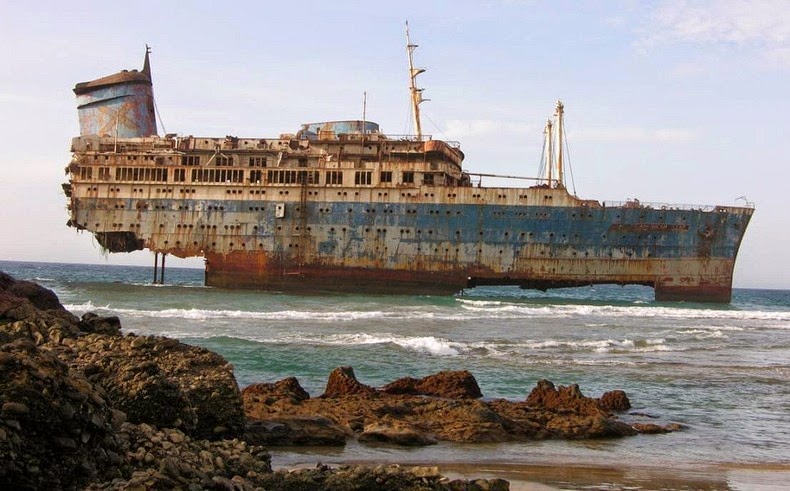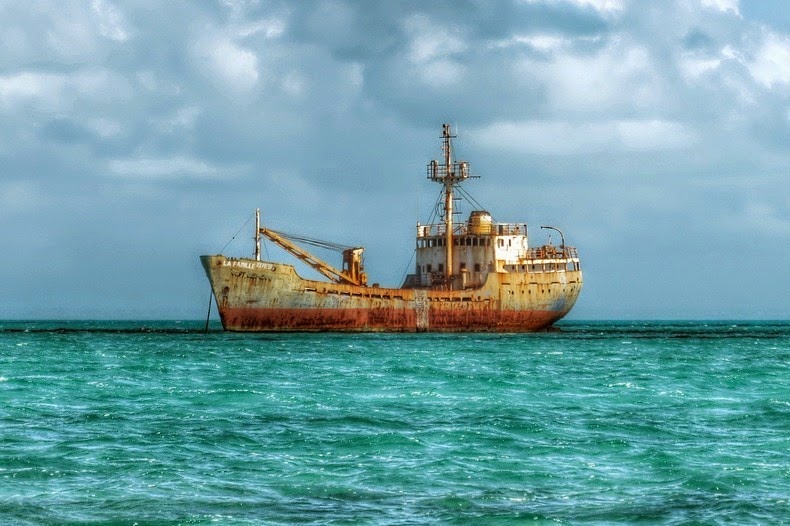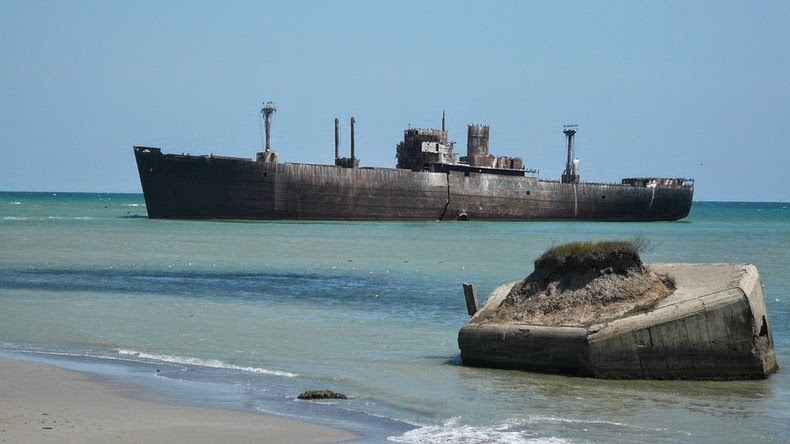There are an estimated three million undiscovered shipwrecks scattered on the oceans’ floor across the world, some of which are thousands of years old. Even the figures for the known wrecks are impressive. For example, the website Wrecksite.eu contains records of more than 148,000 wrecks at the time of this writing. A large number of shipwrecks are historically significant and protected under UNESCO as underwater cultural heritage. Many are abandoned and remain either submerged or grounded near beaches, sometimes gracefully, sometimes not, rotting under the elements of nature. Some of them have turned into tourist attractions because of the many photographic opportunities they offer.
The most recent shipwreck that acquired much media attention was Costa Concordia that turned turtle in the waters near Isola del Giglio, on the western coast of Italy, in January 2012. The capsized ship drew thousands of eager tourist to the area. Salvaging operations were started on mid-2013 and are still on, and it won’t be long before the ship is towed out of the bay.
World Discoverer
The most recent shipwreck that acquired much media attention was Costa Concordia that turned turtle in the waters near Isola del Giglio, on the western coast of Italy, in January 2012. The capsized ship drew thousands of eager tourist to the area. Salvaging operations were started on mid-2013 and are still on, and it won’t be long before the ship is towed out of the bay.
The MS World Discoverer was a cruise ship built in 1974, that made periodic voyages to the Antarctic polar regions to allow its passengers to observe ice floe movements. The vessel had a double hull construction that provided protection for minor impacts. But the rock that punctured the hull on April 30, 2000, was a large uncharted rock in Solomon Islands. After the passengers were safely dispatched via a ferry, the captain steered the ship into Roderick Bay and grounded it to avoid sinking. By the time salvage companies got to it, the ship was ransacked by the locals. The World Discoverer still sits in Roderick Bay on Nggela Island with a 46° list.



Mediterranean Sky



Mediterranean Sky
Mediterranean Sky was originally called City of York when she was built in 1952 in Newcastle, England. The Cruise liner departed London in November 1953, and maintained its service until sold in 1971, when she became the Mediterranean Sky. Her last voyage was in August 1996, when she sailed from Brindisi to Patras.
Due to the companies’ financial situation, the Mediterranean Sky was arrested in 1997, whilst in Patras. Two years later she was towed to Eleusus Gulf in Greece, where she lay abandoned. In late 2002, the ship began to take on water and started to tilt. In order to stop her sinking, she was towed to shallow water and was grounded. In January 2003, Mediterranean Sky keeled over on her side where she remains awaiting her fate.




MV Captayannis
Due to the companies’ financial situation, the Mediterranean Sky was arrested in 1997, whilst in Patras. Two years later she was towed to Eleusus Gulf in Greece, where she lay abandoned. In late 2002, the ship began to take on water and started to tilt. In order to stop her sinking, she was towed to shallow water and was grounded. In January 2003, Mediterranean Sky keeled over on her side where she remains awaiting her fate.




MV Captayannis
The Captayannis was a Greek sugar-carrying vessel that sank in the River Clyde in Scotland in 1974 after colliding with a BP tanker when a severe gale hit the west coast. The tanker suffered no damage but her anchor chains holed Captayannis allowing water to pour in. Captayannis's captain tried to beach her in the shallow waters over the sandbank and steered to the desired spot where she stuck fast. The ship rolled over the next morning, and has lain there ever since. Most, if not all of her more valuable metals and fittings have been removed by looters, leaving little of the split-style superstructure.
Although the wreck lies in relatively shallow waters there has never been any attempt to salvage the remains, as issues such as ownership and insurance were never satisfactorily resolved. Through time Captayannis has become home to marine life and birds. She is known to many locals simply as the "sugar boat".


SS America
Although the wreck lies in relatively shallow waters there has never been any attempt to salvage the remains, as issues such as ownership and insurance were never satisfactorily resolved. Through time Captayannis has become home to marine life and birds. She is known to many locals simply as the "sugar boat".


SS America
SS America was an ocean liner built in 1940. After a long career of more than fifty years, the liner was sold in 1993 with the intention of being refitted to become a five-star hotel ship off Phuket, in Thailand. It was at this time she was renamed “American Star”, although she never sailed by her new name. The ship was towed out of Greece towards the Atlantic to be refitted, but a hundred days later the ship together with the Ukrainian tugboat entered a thunderstorm. The tow lines broke and all attempts to reattach the emergency tow lines proved unsuccessful. The crew aboard American Star was rescued by helicopter but the ship was left adrift. On January 18, the ship ran aground off the west coast of Fuerteventura in the Canary Islands.
Within the first 48 hours of grounding the pounding surf of the Atlantic broke the ship in two just past the second funnel. The stern section collapsed completely to port and sank in 1996, while the bow remained intact. In November 2005, the port side of the bow section collapsed and the hull to begin to break up. By 2007 the entire ship had collapsed and fallen into the sea. Since then, what little remained has been slowly disappearing beneath the waves. As of March 2013, the wreck is only visible during low tide.




The deterioration of the remains of American Star between 2005 and 2007. The stern broke off and sank in 1996, leaving only the bow section on the sandbar. Since that time, the ship has developed a greater list to port, and the funnel has detached and sunk.
Dimitrios
Within the first 48 hours of grounding the pounding surf of the Atlantic broke the ship in two just past the second funnel. The stern section collapsed completely to port and sank in 1996, while the bow remained intact. In November 2005, the port side of the bow section collapsed and the hull to begin to break up. By 2007 the entire ship had collapsed and fallen into the sea. Since then, what little remained has been slowly disappearing beneath the waves. As of March 2013, the wreck is only visible during low tide.




The deterioration of the remains of American Star between 2005 and 2007. The stern broke off and sank in 1996, leaving only the bow section on the sandbar. Since that time, the ship has developed a greater list to port, and the funnel has detached and sunk.
Dimitrios
Dimitrios (previously named "Klintholm"), is a small, 67 meter freight ship built in 1950, that has been stranded on the beach of Valtaki in the prefecture of Laconia in Greece, since December 23, 1981.
There are many rumors about the ship's origins and how it got stranded on the beach. Most relate that the ship was used to smuggle cigarettes between Turkey and Italy. It was seized by the port authorities of Gythio and then deliberately released from the port and left to be dragged by the sea to the beach of Valtaki, about 5 kilometers from the port of Gythio. It was then set on fire to hide the evidence of cigarette smuggling.
However, according to a book written by the Honorary Chief of the Hellenic Coast Guard, Vice Admiral Christos Ntounis the ship had to dock to the port of Gythio on 4 December 1980 in emergency because its captain needed access to a hospital due to a serious illness. After the ship's docking, financial problems arose with the crew as well as various engine problems, coupled with insurance measures imposed by various lenders. The crew was then fired and the ship was side docked to the port of Gythio, where it remained until June 1981 when it was declared unsafe.
The ship was dislodged from its position and swept away to the sea numerous times before being stranded at its current location on the beach of Valtaki. The ship remains abandoned and there has been no attempts to recover it.


There are many rumors about the ship's origins and how it got stranded on the beach. Most relate that the ship was used to smuggle cigarettes between Turkey and Italy. It was seized by the port authorities of Gythio and then deliberately released from the port and left to be dragged by the sea to the beach of Valtaki, about 5 kilometers from the port of Gythio. It was then set on fire to hide the evidence of cigarette smuggling.
However, according to a book written by the Honorary Chief of the Hellenic Coast Guard, Vice Admiral Christos Ntounis the ship had to dock to the port of Gythio on 4 December 1980 in emergency because its captain needed access to a hospital due to a serious illness. After the ship's docking, financial problems arose with the crew as well as various engine problems, coupled with insurance measures imposed by various lenders. The crew was then fired and the ship was side docked to the port of Gythio, where it remained until June 1981 when it was declared unsafe.
The ship was dislodged from its position and swept away to the sea numerous times before being stranded at its current location on the beach of Valtaki. The ship remains abandoned and there has been no attempts to recover it.


Olympia
The Olympic was a commercial ship that was driven ashore near the town of Katapola, on Amorgos island in Greece, apparently by pirates, in 1979 while coming from Cyprus and heading for Greece. After an unsuccessful attempt to pull the ship out of the gulf, it was abandoned there and became one of Amargos Island’s most popular landmark.



BOS 400



BOS 400
The BOS 400 is a French Barge that ran aground in Maori Bay in South Africa, while being towed by a Russian tugboat on June 26, 1994. The Boss 400 was the biggest floating crane in Africa when the towing lines broke and hit the rocks in a storm. Being a barge and having no main engines of its own it had to be towed to wherever it was working in the world.
The tug boat was chartered to tow the BOS 400 from the Republic of Congo to Cape Town, South Africa. The tow-rope broke loose during a storm and causing the vessel to run aground off Duiker Point near Sandy Bay were she has been lying ever since. Despite several towage attempts, the shipwreck was considered a total loss as salvors were able to recover little from the wreck.



La Famille Express
The tug boat was chartered to tow the BOS 400 from the Republic of Congo to Cape Town, South Africa. The tow-rope broke loose during a storm and causing the vessel to run aground off Duiker Point near Sandy Bay were she has been lying ever since. Despite several towage attempts, the shipwreck was considered a total loss as salvors were able to recover little from the wreck.



La Famille Express
The shipwreck of the La Famille Express lies off the southern waters of Provo in the Turks and Caicos Islands, in the Caribbean Sea. The ship was built in 1952 in Poland and a large part of its life serviced in the Soviet Navy as the “Fort Shevchenko”, until 1999 when it was sold and renamed “La Famille Express”. The circumstances of the wreck are not clearly known, except for that it ran aground during the Hurricane Frances in 2004. Nobody salvaged the ship so far and many parts fell prey to looters. Right now, the ship is a great local landmark attraction tourists coming to this area


HMAS Protector


HMAS Protector
HMAS Protector was a large flat-iron gunboat purchased by the South Australian government in 1884, for the purpose of defending the local coastline against possible attacks in the aftermath of the ‘Russian scare', of 1870s. She arrived in Adelaide in September 1884 and subsequently served in the Boxer Rebellion, World War I and World War II. During July 1943, Protector was requisitioned for war service by the US Army. On the way to New Guinea and off Gladstone, she was damaged in a collision with a tug and abandoned. The hull was subsequently taken to Heron Island off the Queensland coast and later sunk for use as a breakwater. Her rusting remains are still visible to this day.


Evangelia


Evangelia
Evangelia was a merchant ship, constructed by the same shipyard which built the Titanic, and launched on 28th of May, 1942 with the name of "Empire Strength". Later she was known as "Saxon Star", "Redbrook" and eventually "Evangelia".
In 1968, during a night of dense fog, Evangelia sailed incredibly close to the shoreline and became grounded near the shoreline near Costinesti. Some say that Evangelia was deliberately wrecked by the owner to collect the insurance money. The hypothesis is supported by the fact that during the time of this catastrophe, although the haze has been very dense, the sea was incredibly tranquil and also almost all sailing equipment worked perfectly.


SS Maheno
In 1968, during a night of dense fog, Evangelia sailed incredibly close to the shoreline and became grounded near the shoreline near Costinesti. Some say that Evangelia was deliberately wrecked by the owner to collect the insurance money. The hypothesis is supported by the fact that during the time of this catastrophe, although the haze has been very dense, the sea was incredibly tranquil and also almost all sailing equipment worked perfectly.


SS Maheno
SS Maheno is the most famous shipwreck of Fraser Island, in Australia, and has become a landmark attraction. Built in 1905, the SS Maheno was one of the first turbine-driven steamers. She plied a regular route between Sydney and Auckland until she was commissioned as a hospital ship in Europe during World War One.
In 1935, she and her sister ship the Oonah were sold to Japan for scrap. While being towed to Japan, the ship encountered a severe cyclone and the towline snapped. Attempts to reattach the towline failed in the heavy seas, and the Maheno, with eight men aboard, drifted off and disappeared. The ship was finally found 3 days later beached off the coast of Fraser Island, and the crew had set up camp onshore. The ship was subsequently stripped of her fittings, but attempts to refloat her failed, and eventually the wreck was offered for sale, but found no buyers. Since then, much of the ship has either been destroyed or disintegrated, and the visible remainder has become severely rusted.



Santa Maria
In 1935, she and her sister ship the Oonah were sold to Japan for scrap. While being towed to Japan, the ship encountered a severe cyclone and the towline snapped. Attempts to reattach the towline failed in the heavy seas, and the Maheno, with eight men aboard, drifted off and disappeared. The ship was finally found 3 days later beached off the coast of Fraser Island, and the crew had set up camp onshore. The ship was subsequently stripped of her fittings, but attempts to refloat her failed, and eventually the wreck was offered for sale, but found no buyers. Since then, much of the ship has either been destroyed or disintegrated, and the visible remainder has become severely rusted.



Santa Maria
Santa Maria was a Spanish freighter that was carrying an impressive number of gifts from the Spanish Government of Francisco Franco to be given to those who had supported him during the economic crisis through which Spain had passed - on board were sports cars, food, medicine, machines, clothing, china, beverages, etc. On September 1, 1968 the ship was passing Cape Verde islands on its way to Brazil and Argentina when it ran aground. After a local tugboat tried to save the ship unsuccessful, it was abandoned there, not before all the precious cargo was carefully removed. The wreckage of the Santa Maria has since become a symbol of Boa Vista and Cape Verde.








 Posted in:
Posted in: 





















0 comments:
Post a Comment